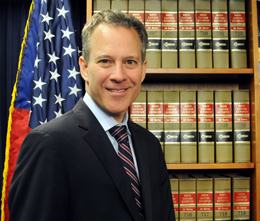 13 AGs File Amicus Brief In Husted v. A. Philip Randolph Institute, Arguing That Ohio’s Process Of Deregistering Voters Violates Federal Law
13 AGs File Amicus Brief In Husted v. A. Philip Randolph Institute, Arguing That Ohio’s Process Of Deregistering Voters Violates Federal Law
New York Attorney General Eric T. Schneiderman, leading a coalition of 13 Attorneys General, filed an amicus brief with the U.S. Supreme Court in defense of voting rights under the National Voter Registration Act.
The brief, filed in Husted v. A. Philip Randolph Institute (No. 16-980), argues that Ohio’s practice of deregistering voters under a “Supplemental Process” – which relies only on a registrant’s failure to vote during a two-year period as the basis for subjecting the voter to a removal process – violates the National Voter Registration Act of 1993, as amended by the Help America Vote Act of 2002. Ohio has justified its reliance on voter inactivity on the ground that a failure to vote is evidence that the voter has moved away and is thus no longer eligible to vote. But the amici States argue that many eligible voters do not vote for reasons having nothing to do with changing residence; that a deregistration process triggered by a failure to vote will disproportionately exclude certain voters – particularly minorities, low-income, and disabled voters; and that there are more direct and reliable ways to identify voters who have moved.
“The right to vote is at the heart of our democracy. The National Voter Registration Act makes clear: eligible voters should have equal access at the polls – and states have an obligation to enhance that participation, not undermine it,” said Schneiderman. “Policies like Ohio’s threaten to disenfranchise our most vulnerable citizens – minority, young, low-income, and disabled voters – who already vote at lower rates. My office will continue to fight to protect each and every voter’s rights.”
Click here to read the brief, which was led by Schneiderman and filed by the Attorneys General of New York, California, Connecticut, Delaware, Hawai’i, Illinois, Iowa, Kentucky, Maryland, New Mexico, Oregon, Washington, and the District of Columbia.
The brief highlights Schneiderman’s Report on Voter Access in the 2016 Presidential Primary in describing how erroneous deregistration is a serious problem that disenfranchises voters. The brief also notes that “voter fraud of any stripe has been ‘highly unusual’ in recent years,” citing the fact that Schneiderman received zero substantiated complaints of voter fraud during last year’s general federal election. Schneiderman has also introduced the New York Votes Act, to protect and expand voting rights in New York.
“Like Ohio, amici States of New York, California, Connecticut, Delaware, Hawai’i, Illinois, Iowa, Kentucky, Maryland, New Mexico, Oregon, Washington, and the District of Columbia are responsible for maintaining accurate and up-to-date statewide voter registration rolls in a manner consistent with the National Voter Registration Act and the Help America Vote Act. These federal statutes were enacted to ensure that the States administer the voter-registration process for federal elections in a manner that ‘enhances the participation of eligible citizens as voters,’ rather than serving as a barrier to voting. In particular, Section 8 of the NVRA, while recognizing that States should remove ineligible persons from the voter rolls, prohibits any maintenance procedure that ‘result[s] in the removal . . . of any person from the official list of voters registered to vote . . . by reason of the person’s failure to vote,’” the brief reads.
“Amici States submit this brief to explain, on the basis of their experience, that States have a broad array of other, better tools to identify voters who have changed residence. In light of these other available options, reliance on voter inactivity during only a two-year period to target registrants for potential removal poses unacceptable risks of disenfranchising eligible voters and thus undermines rather than enhances the accuracy of voter registration rolls.
“Voter inactivity is a poor measure to identify ineligible voters. Ohio presumes that a registrant who has failed to vote in a single federal election has likely moved outside his registration jurisdiction. But in any particular election, many people decline to vote for reasons having nothing to do with changing their residence. And voter turnout among particular demographic groups—including racial minorities, young voters, poor voters, uneducated voters, and voters with disabilities—historically has been even more depressed than in the general population. Targeting nonvoters for a State’s deregistration process thus threatens to disenfranchise many eligible voters, particularly in populations with lower rates of voter turnout.”
